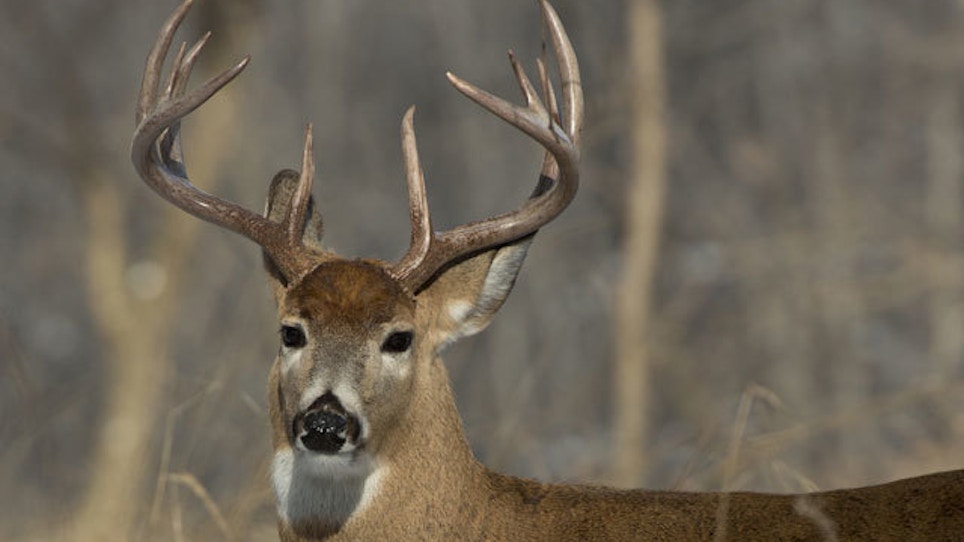Over the winter you’ve talked to your hunting friends about taking an out-of-state deer hunt this fall. You’ve also watched a ton of television hunting shows filmed somewhere in the Midwest, from Texas (yes, for our discussion, we’ll put Texas in the Midwest) to Wisconsin, and all enticed you to take your dreams there. Then there were the sport shows, and you walked past booth after booth of Midwest hunting guides, all wanting you to hunt with them. Maybe now is the time to finally take the out-of-state plunge, and there are lots of Midwestern states to pick from, but where do you go? I don’t have magical answers, but when I went to the 2014 Quality Deer Management Association Whitetail Report, I found some things to consider as you make your plans.
One consideration is to go where there are lots of bucks. So, let’s check out the states with the highest buck harvests. The top five states for antlered buck harvest for 2012 were Texas (304,035), Michigan (222,640), Wisconsin (165,457), Pennsylvania (133,860) and Georgia (130,115). Of course there are many variables that led to these numbers. One variable is the number of hunters in that state; another is the bag limit, as that will obviously impact buck harvest numbers. A third factor is the season length, and another is the size of the state. Several of these variables explain why some key Midwestern states such as Ohio, Illinois, Iowa, Missouri and Kansas are missing from the above list.
We can eliminate the “size of the state” variable by looking at buck harvest per square mile. When we do that, some of the Midwestern states are near the top. Although the overall average of bucks killed per square mile in the Midwest is 1.5, Texas is way up there with 5.8 bucks taken per square mile of deer habitat. Wisconsin is 4.4, and Indiana is 4.3.
Several of these variables make the Midwestern states a great place to hunt bucks. Number of hunters is one factor that makes Kansas a great state to harvest big bucks. They just don’t have that many resident hunters compared to states like Michigan or Pennsylvania, and that means that more bucks live to an older age.
Even though Iowa hunters harvested only 47,927 bucks in 2012 — nowhere near the top five states listed above — we know the quality of bucks taken there is tremendous. The same can be said for Kansas, with a harvest of 43,421. Chances are that your home state took more bucks than either Iowa or Kansas in 2012, but make no mistake, these are great states to chase big bucks. They, along with Ohio, Indiana, Illinois and Missouri all have rich soil, lots of high-protein food, and mature bucks.
If you look at the states with the most listed Boone-and-Crockett bucks over the past four years, you will find Wisconsin, Ohio, Illinois, Kentucky and Indiana right on top. Some might be surprised at the listing of Indiana, and some may even be surprised with Kentucky being high on this list. But several years ago, both states went to a one-buck limit and increased doe harvests, and those have been major factors leading to a big increase of quality bucks. The habitat was always there, but now more bucks grow to maturity because buck limits were dropped to one.
Speaking of mature bucks, one key factor when considering where to go for your out-of-state deer hunt is the age structure of bucks that are harvested. Interestingly, from a nationwide perspective, the percentage of yearling bucks in the harvest continues to decline. For 2012, yearlings made up 37 percent of the buck harvest, and of course this means that there are more older, mature bucks out there for hunters. Considering that in 1999 half the whitetail buck harvest in the country was composed of yearlings, this latest data is impressive and welcome. Fewer yearlings in the harvest means more older bucks in the field.
States with the lowest yearling buck harvest rates are Arkansas (8 percent), Kansas (14), Texas (14), Oklahoma (15) and Louisiana (17). Yep, the Midwest is prominent here. Another way to look at this is to consider the states with the highest harvest of older bucks. The top five states with the highest harvest of 3½-year-old and older bucks were Texas (67 percent), Oklahoma (66), Arkansas (65), Louisiana (59) and Kansas (45). Texas can achieve such a high harvest of older bucks because most of the state is private ranches, and many of those do not allow the harvest of younger bucks.
Oklahoma is a bit unusual because they have such a low harvest of yearling bucks, but they don’t have any antler restrictions. In other words, it is legal for hunters to take small, young bucks, but they don’t — and the reason is because the Oklahoma Department of Wildlife Conservation has had an aggressive educational campaign, and their “Hunters in the know … take a doe” campaign has changed the mindset of their hunters. More recently that agency followed up with a “Hunters in the know … let young bucks grow” campaign that is paying big dividends. In 2010, 51 percent of Oklahoma’s buck harvest was composed of bucks 3½ years old and older. Two years later that number has climbed to 66 percent. That is a huge achievement in a short period of time, and they did it with no legal mandates. No wonder more and more hunters are heading to Oklahoma to deer hunt.
Midwest states with a reputation for big bucks have a very good record when it comes to older bucks in the harvest. Iowa and Illinois did not provide data, but Missouri had 44 percent of their buck harvest in the 2½-year-old category and another 31 percent at 3½ or older. Ohio had 31 percent of their buck harvest in the 2½-year-old category and another 23 percent at 3½ or older. Kentucky is fast becoming a great hunting destination, and they had 39 percent of their buck harvest in the 2½-year-old category and another 29 percent at 3½ or older. Nebraska, even with a loss from hemorrhagic disease, still had 38 percent of bucks harvested in the 2½-year-old category and another 34 percent at 3½ or older. And you can’t forget Kansas. In my mind Kansas is the best big-buck state in the country, and the data supports that. They had 41 percent of their harvested bucks in the 2½-year-old age class and another 45 percent at 3½ or older.
Now that we know some of the data for where bigger bucks are found, how does that translate into a successful harvest? There is no data for bucks, but there is data for successful deer (bucks and does) harvest. If we look at the Quality Deer Management Association (QDMA) data for 2011, we find that in the United States, 48 percent of all deer hunters got at least one deer. In the Northeast region, 43 percent of deer hunters were successful. The Southeast showed a 58-percent success rate. In the Midwest the total success rate was 42 percent, and Indiana topped all Midwestern states with 56 percent of all deer hunters taking at least one deer. Fourteen percent of those took three deer. (Yes, another reason Indiana has risen in big-buck harvest is the fact that they harvest lots of does.) Success rates in some of the other great Midwestern hunting destinations were Illinois (43 percent), Iowa (43), Missouri (40), Wisconsin (39) and Ohio (35).
When considering your out-of-state hunt, length of season might be a factor. In general, the Midwest bow seasons are fairly long while gun seasons are rather short. The gun season in Illinois is seven days; Wisconsin is nine, Nebraska nine, Missouri 11, Kansas 12, Iowa 14, Indiana 16 and Kentucky 16.
Antlerless harvest can influence the quality of bucks simply because does eat lots of food. You only need so many does to maintain or grow a deer herd, so increased doe harvest, in many areas, will increase buck quality. Two prime examples of that are Indiana and Kentucky, where doe harvests in 2010 were 80,997 and 51,208, respectively, but climbed to 90,312 and 67,212 in 2012. On the opposite end of that spectrum, North Dakota, South Dakota and Nebraska have all dropped their doe harvests significantly because of hemorrhagic outbreaks the past several years. This management strategy should lead to a rebound of deer populations in those states.
Buck bag limits also have a great impact on the numbers of mature bucks to hunt. Kansas, Iowa and Indiana all allow only one buck. Illinois allows two bucks, but one must be taken with the bow and one with a gun. The same is true in Missouri where you can take two bucks, but one must be with a bow and the other with a gun (or with a bow after the gun season). Wisconsin allows one buck, but there are various exceptions relative to CWD areas. Go to their website (www.dnr.wi.gov) to see their deer-hunting regulations. The maximum number of bucks you can harvest in Texas is three, but antler restrictions (antler spread) apply in many counties. Since most nonresident hunters in Texas will be hunting on guided hunts, rely on your guide for local laws on buck harvest limits.
What about buying a nonresident license? Most Midwestern states are over-the-counter purchases. Illinois used to be a draw, but no longer. Kansas is a draw, and the license deadline to apply is April 25. But if you miss that deadline, go to the Department of Wildlife and Parks website (www.kdwpt.state.kansas.us) and look by region for leftover permits. I’ve used that approach twice in recent years with success. Iowa is the tough one, and you need to apply for a permit. The dates to apply are between May 3 and June 1. In my experience you need two or three preference points to get drawn. If you do not draw, you get one preference point. During the same application deadline, you can also apply for a preference point for a cost of $50.
There you have it. Some numbers and data to consider as you decide where to take that Midwestern deer hunt. Most will use a guide on such hunts and there are lots of things to consider as you do that. But that is fodder for another column. Good luck this coming fall and take advantage of every opportunity to hunt.
Photo credit: SteveOehlenschlager/Getty Images/iStockphoto/Thinkstock






